Shiliuyun-Xinjiang Daily (Reporter Abibai) news: From July 8 to 13, 2024, the horseback events of the 12th National Traditional Games of Ethnic Minorities (hereinafter referred to as the Games) are being held in Zhaosu County, Ili Kazak Autonomous Prefecture, northwest China's Xinjiang Uygur Autonomous Region. During this period, there will be competitions such as horse racing, archery on horse, and picking Hada on horse, as well as performances such as the Buzkashi (horseback competition for possession of a goat) and acrobatics on horse.

Photo shows horse racing. (Photo by Nurmamat)
Equestrianism stems from the primal production and labor endeavors of our ancestors, and China boasts a rich and storied tradition in this field. It flourished prominently during the Zhou Dynasty and reached new heights in the Tang Dynasty. The legendary Tian Ji's Horse Racing, which took place during the Spring and Autumn and Warring States periods, continues to resonate in the hearts of people even today. The horseback events showcased at the Games are the culmination of relentless exploration, development, and gradual standardization by individuals of diverse ethnic backgrounds over extended periods of practice. These events enjoy a vast and profound foundation among the masses.
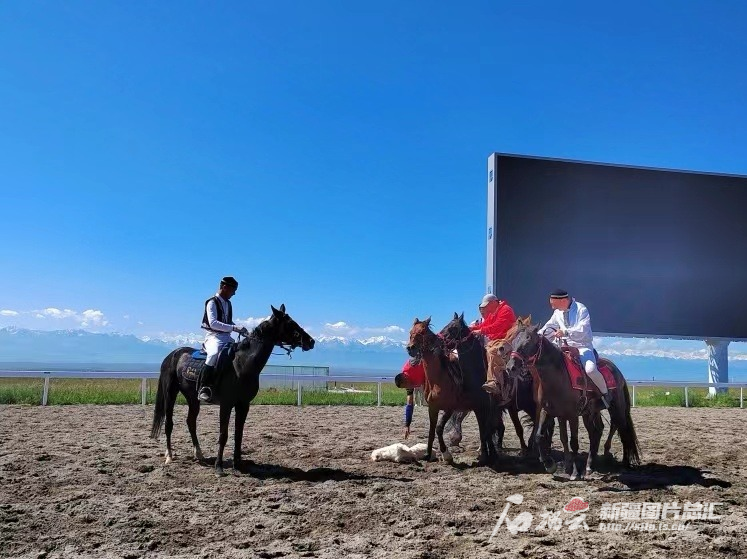
Photo shows the Buzkashi (horseback competition for possession of a goat) at the horse racing track of Tianma Tourism and Culture Park in Zhaosu County, Ili Kazak Autonomous Prefecture in northwest China's Xinjiang Uygur Autonomous Region. (Photo by Dong Liang)
The events, particularly those involving horses, have extremely high requirements for the venue. The Zhaosu Tianma Tourism and Cultural Park, which hosts this prestigious competition, encompasses an area of 460 mu (about 30.7 hectares). The competition field is comprehensively equipped with viewing stands, racetracks, tourist service areas, and more. The racetrack itself boasts a total length of 2,000 meters and a width of 28 meters, featuring a smooth and even surface. The sandy ground has undergone multiple rounds of refinement to ensure it remains firm, free of loose soil, gravel, and sand dunes. Furthermore, the park is equipped with specialized starting gates for racehorses, rendering it fully capable of hosting international-level equestrian events.
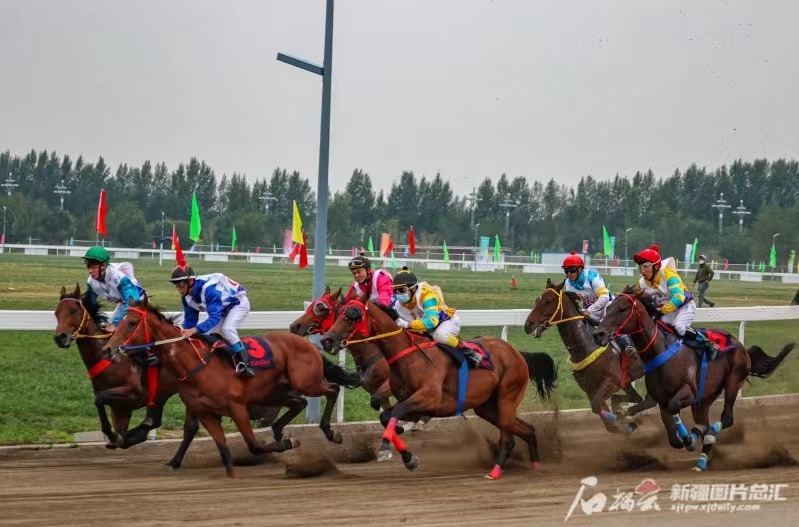
Photo shows horse racing. (Photo by Han Liang)
Among the events of this Games, the ethnic horse racing category focuses on speed, where horses gallop at their fastest pace. The "Zouma" (walking horse race), on the other hand, emphasizes maintaining a steady gait while racing, with the objective being to traverse the course swiftly yet gracefully. The horse-racing archery event combines the thrill of speed with precision, as contestants aim to hit the target from a designated distance in the shortest possible time, with the winner being the one who scores the most hits.
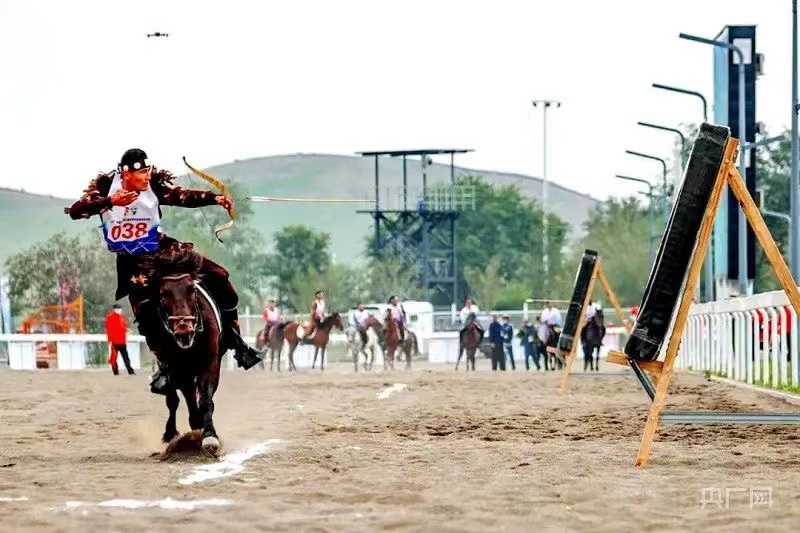
Photo shows horse-racing archery. (Photo by Nan Deng)
Horseback archery can be divided into two categories: stationary archery and horse-racing archery. With stationary archery, the horse stands still while the rider aims and shoots arrows towards the target. On the other hand, horse-racing archery involves the rider firing arrows at the target while the horse is in full gallop. This exciting sport was officially included in the fifth National Traditional Games of Ethnic Minorities in 1995, marking its recognition as a formal competition event.

Photo shows horseback hada-picking. (Photo by Han Liang)
In the horseback hada-picking event, players on horseback are required to pick up the "hada" off the ground. It is a thrilling competition held within a designated area, where the winner is determined by the rider who can pick up the most “hada” from the ground in the shortest time. Riders charge forward on their steeds, leaning forward and reaching out with agility to swiftly collect the flower baskets or “hada” scattered along the course. Upon retrieving each item, they straighten up and hold it high in the air, earning rounds of applause from the cheering spectators. Skilled riders demonstrate remarkable dexterity and precision, making the task of horseback picking seem effortless. This event poses stringent requirements for both the riders and their horses. Recognizing its appeal and challenge, Horseback hada-picking was officially included as a competition event in the fifth National Traditional Games of Ethnic Minorities in 1995.

Photo shows performance on horseback. (Photo by Abibai)
The horse-walking event, or "Zouma" in Chinese, has evolved from the art of horse training. In this event, strict adherence to the prescribed walking gait is mandatory. Any deviation from the required posture or attempt to run will result in disqualification. Within the specified racecourse, only the leading horse that maintains the prescribed gait throughout the competition is eligible for ranking. Consequently, "Zouma" boasts a high degree of spectator appeal, offering a captivating display of equine prowess.
The walking gaits in "Zouma" can be classified into several categories, including the left-right hoof pattern, the four-hoof stepping pattern, and the double-hoof landing pattern. Among the folk traditions, there are further distinctions such as the sheep-style walk, camel-style walk, short-step walk, and brisk walk. Reflecting its growing popularity and recognition, "Zouma" was formally included as a competition event in the fifth National Traditional Games of Ethnic Minorities held in 1995.
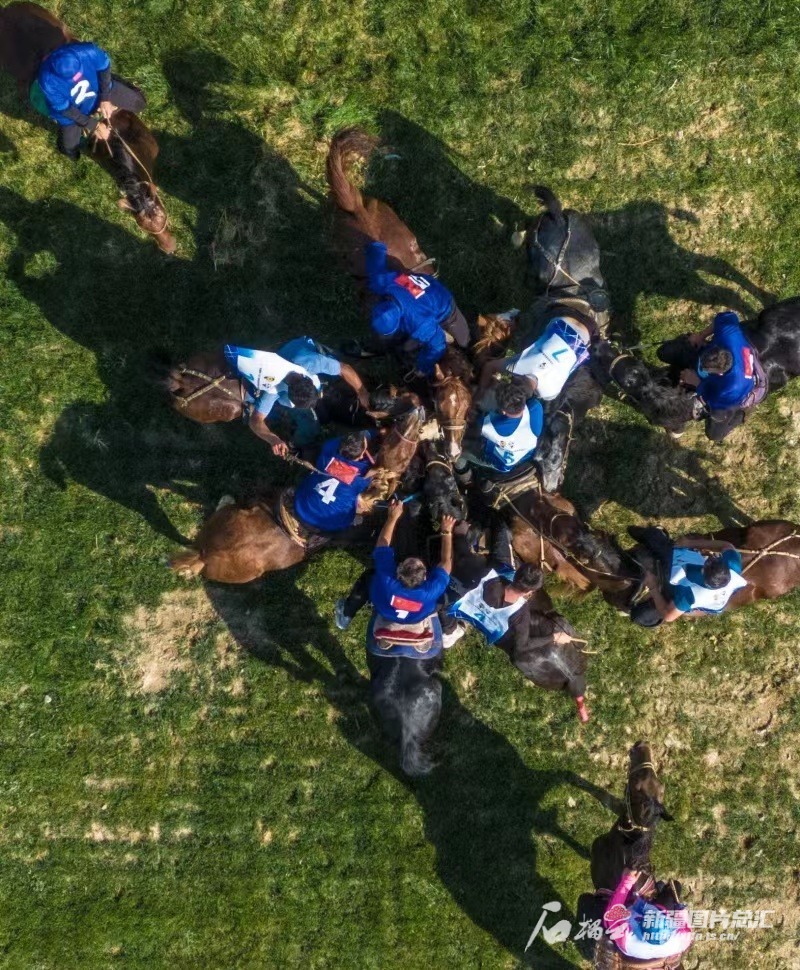
Photo shows the Buzkashi (horseback competition for possession of a goat). (Photo by Nan Deng)
"Diao Yang," or Buzkashi (horseback competition for possession of a goat) is a traditional folk entertainment game originating among the nomadic peoples of northern China. This exhilarating activity showcases teamwork and horsemanship as competitors vie for possession of a goat while mounted on horseback. The game takes place within a designated area, where two teams, each consisting of five riders and five horses, compete against each other. The objective is to accumulate the highest score within a specified time limit. Regardless of who emerges victorious, the sheep that has been the focus of the intense competition becomes a shared delicacy, enjoyed by both teams as they celebrate together.
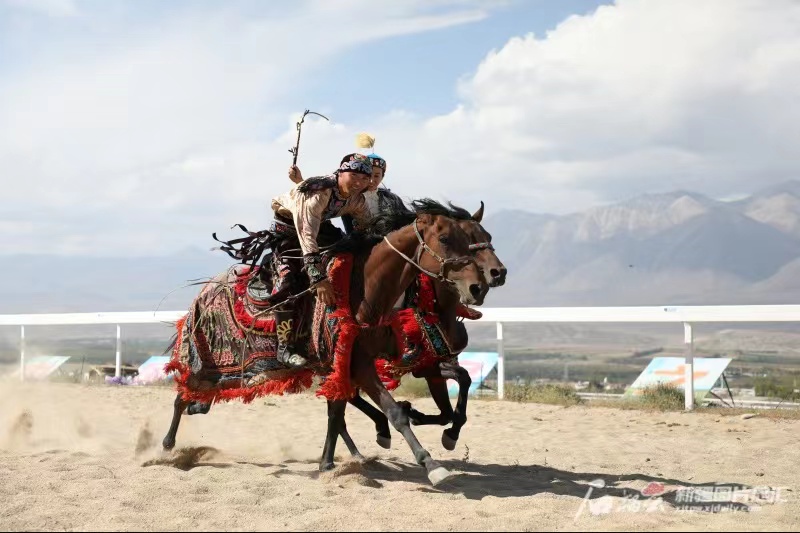
Photo shows Kyz kuu (a traditional Kazak entertainment) performance. (Photo by Abibai)
Kyz kuu, features a male and female rider pairing up on horseback and racing towards a designated point. Along the way, the two engage in playful teasing and lighthearted scuffles, not only as a test of horsemanship, but also as a traditional means of fostering affection and expressing love. This enchanting display is often showcased during weddings, festivals, and other joyous occasions in Xinjiang, adding a vibrant and romantic touch to the celebrations. Recognizing its rich cultural significance and heritage value, Kyz kuu was inscribed on the fifth batch of the National Intangible Cultural Heritage List in 2021.
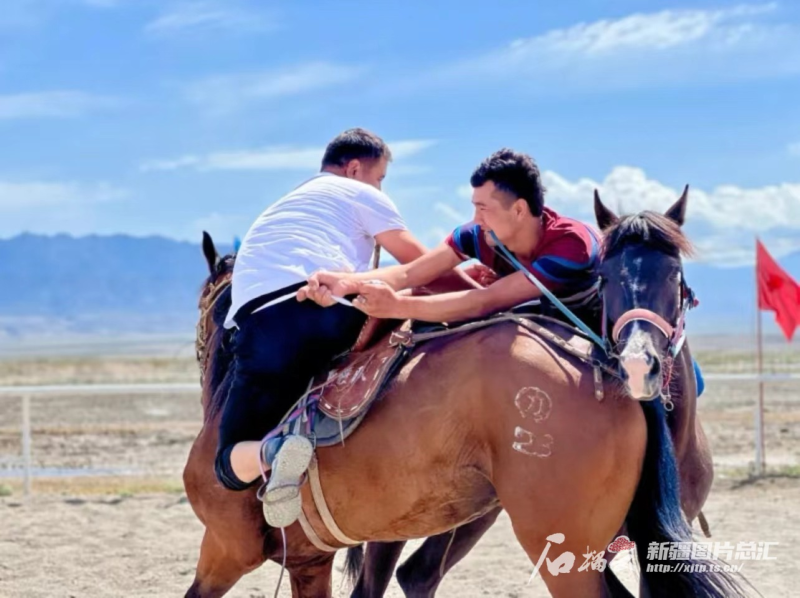
Photo shows the horseback wrestling. (Photo by Nan Deng)
The sport of "horseback wrestling," also known as "Jueli" in the context of horseback competitions, is a cherished tradition among ethnic minorities that embodies a thrilling blend of strength, wisdom, skill, and equestrian prowess. In this exhilarating competition, two riders face off, each mounted on their steed, in a test of physical might and strategic cunning. The rules of horseback wrestling dictate that participants can only use their hands to grasp their opponent's arms in an attempt to pull them off their horse. Any attempt to grab any other part of the opponent's body or to touch their opponent's tack, such as the saddle or reins, is considered a foul. Given the inherent risks involved, horseback wrestling requires riders and their horses to undergo lengthy periods of practice to signify the harmonious blending of rider and horse through mutual understanding and trust.

Photo shows horse riding performances. (Photo by Abibai)
Horse-riding performances, a captivating blend of athleticism and artistry, showcase a remarkable array of high-difficulty maneuvers executed at breakneck speeds atop the galloping horses. While the beauty and precision of these performances are preferred, they also carry a significant element of danger.
(A written permission shall be obtained for reprinting, excerpting, copying and mirroring of the contents published on this website. Unauthorized aforementioned act shall be deemed an infringement, of which the actor shall be held accountable under the law.)









